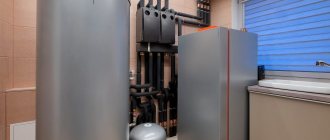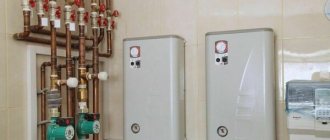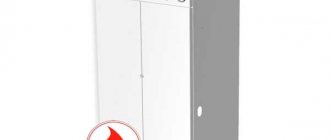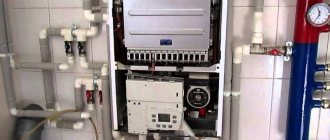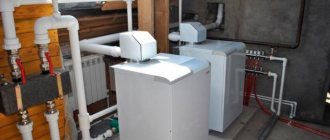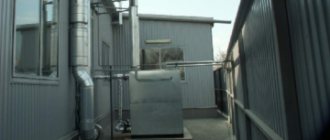Before the start of the winter season, many new owners of private houses are thinking about which boiler to choose in order to keep the house warm and cozy in cold weather.
For many owners of country houses that are heated with gas, the solution to this issue lies only in choosing a boiler that uses gas as the main type of fuel.
The purchased equipment must comply with the following principles:
- productivity;
- efficiency;
- reliability;
- safety.
Cast iron gas boilers correspond to these characteristics, both according to the conclusions of experts and according to statements from buyers.
Features of cast iron boilers
For many decades, heating equipment made of cast iron has served and continues to function properly, since it was used mainly as a heating circuit. The popular use of cast iron is based on the fact that the material is very reliable and very durable.
A cast iron boiler fits into almost any heating circuit, and it is designed to allow the most common and cheapest coolant to circulate inside it, namely water. And at the same time, cast iron, as a material, is capable of withstanding quite critical loads, namely:
- strong pressure drops in the circuit;
- fluctuations that may accompany fuel supply;
- incorrect draft in the operation of the chimney due to bad weather conditions.
The cast iron gas boiler in the product line of many manufacturers is sold with a good warranty period. This suggests that the manufacturer himself is confident in the durability of the product. For example, boilers made of steel are sold with a guarantee for a period of 12-14 years, and the same boilers, but using cast iron instead of steel, are given a guarantee of 38-56 years. If the buyer wants to clarify the exact period covered by the warranty, then it is necessary to determine the manufacturer and model.
There are, of course, some points that affect the time it takes for a boiler to operate under any individual conditions:
- it is necessary to carry out installation that complies with all correct standards;
- regular boiler maintenance by a technician;
- good compatibility with all components of the system.
An example of a retro boiler - AGV-80 and modifications
AGV-80, the photo of which is shown above, belongs to the old type of heating boilers. It has one circuit (heating water for domestic needs). Production of the model began in 1939 at the Zhukovsky Machine-Building Plant. The reason for this was the mass gasification in the USSR and the use of gas for heating domestic premises.
The boiler is a cylinder on three legs, in the upper part of which there is a chimney pipe. The cylindrical tank is made of steel, sealed, with a volume of 80 l. Inside the tank is a flame tube, under the mouth of which an atmospheric burner is installed. To reduce the speed of heated gases escaping into the pipe and increase the degree of heating of the tank walls, a turbulator is mounted inside the pipe. The efficiency of the device reaches 80%.
Equipment:
- thermometer;
- traction fuse.
When the pressure drops or the maximum water temperature reaches, these devices allow you to shut off the gas supply.
The design of this boiler served as the basis for the company's developers to produce improved models AOGV (for CO) and AKGV (with two circuits), the efficiency of which is up to 89%.
In addition to a similar design, the new generation gas boilers include:
- coil (for supplying water for household needs);
- the flame tube is divided into sections, each of which contains a turbulator;
- traction sensor;
- air regulator;
- automatic start;
- automation unit for regulating boiler operation and temperature.
Construction of the AVG-80 boiler
Specifications
Cast iron gas boilers are the most popular heating units, which, according to their technical characteristics, are most suitable for use in buildings intended for permanent residence.
The operating principle of all cast iron boilers operating on gas is built as follows: heat is released, which owes its appearance to the fact that the fuel is burned and the air is heated. In short, the next stage of work occurs, that is, when fuel such as gas enters the combustion chamber, it burns and transfers all the heat to the coolant.
Then the coolant, which circulates through the system in a closed loop, is supplied to the batteries and the room heats up - the batteries begin to give off heat.
The technical characteristics of gas boilers with a cast iron heat exchanger differ in that:
- such a device does not require constant operation, since the heat exchanger retains heat well, and the temperature sensor, detecting temperature fluctuations, does not perform manipulations that will start the boiler;
- One of the main parameters that dominates the technical characteristics is the durability of this type of material, even though the conditions may be extreme.
Manufacturers
Currently, on the Russian market you can find a large number of different models of cast iron gas boilers, which are produced by different manufacturing companies. Let's look at the most popular of them.
Ariston (Italy)
Gas boiler with cast iron heat exchanger Ariston Unobloc
The Ariston company produces atmospheric gas cast iron boilers of the Unobloc series. They are well suited for domestic operating conditions, are reliable and have a long service life. The efficiency of the devices is high, reaching up to 90%. The model range is represented by devices with power from 24 to 64 kW.
The cast iron heat exchanger is not subject to corrosion processes and various thermal stresses. The atmospheric burner includes electric ignition and ionization flame control. Ariston boilers, whose power varies from 24 to 31 kW, include a circulation pump, an expansion tank, a safety valve and a minimum pressure switch.
Thanks to the large variety of units made in a variety of design solutions, everyone can choose a heating device that will not only become a source of heat, but will also fit perfectly into the interior.
Biasi - Italian gas boilers with a cast iron heat exchanger.
Baxi (Italy)
Models of floor-standing gas boilers with a cast iron heat exchanger Slim from Baxi got their name due to their small dimensions (width is only 35 cm). In this regard, they can be placed in any room, even the smallest. The manufacturer offers units with atmospheric and inflatable burners. Power ratings range from 15 to 62 kW.
During the operation of boiler equipment, continuous electronic modulation of the flame occurs both in heating mode and in hot water supply mode. These Baxi cast iron boilers are highly safe; they are equipped with an electronic self-diagnosis system, ionization flame control, a protective thermostat against overheating of the liquid in the primary heat exchanger, as well as a draft sensor to control the removal of combustion products.
If your boiler room is quite large and you need a more powerful boiler, then Baxi offer a range of units with an atmospheric burner, the power of which ranges from 83 to 116 kW. The boilers are very well adapted for operation in Russian conditions.
Gas floor-standing boiler Baxi SLIM
Electrolux (Sweden)
Floor-standing gas boiler Electrolux FSB 50 Mi
Electrolux cast iron heating boilers are represented by the FSB series, which includes both single-circuit and double-circuit devices with natural removal of combustion products.
Due to the fact that production is carried out using the most modern technologies, the devices have a long service life and are very economical in fuel consumption.
It is worth noting that Russian cast iron gas boilers are not much inferior to their European counterparts in their technical and operational characteristics and are also very popular among users.
Thanks to a sectional cast iron heat exchanger made using Drop Stop technology, an Electrolux gas boiler can operate successfully for 25-30 years.
Options for cast iron gas boilers
Cast iron gas boilers for heating a private house differ in the following parameters:
- Burners. According to the type to which the burners themselves belong:
- atmospheric burners;
- or with fans;
- Burners can also be used that use the principle of forced, that is, artificial, air pressurization, which causes a total pressure of all supplied fuel.
- They also differ in the type used in the installation of the thermal structure:
- floor;
- wall-mounted
- According to the method used to remove residues and combustion products in the form of smoke. Turbocharged ones are used, but a prerequisite for use is the availability of electricity. Or chimneys.
- General functionality: either those that operate in one circuit, that is, capable of heating only the room, or dual-circuit, heating not only the room, but also water intended for a variety of home uses.
And also a gas cast iron heating boiler has a main difference from analogues made of steel; it has a prefabricated and sectional design. The assembly of such a unit occurs exclusively by hand.
The technical characteristics also include the following points:
- Thermal engineering data are very different from other materials - after cast iron heats up, it gives off heat for a long time;
- quite resistant to acids and aggressive environments;
- if any parts of the exchanger are damaged, they can easily be replaced due to the fact that the structure is prefabricated;
- cast iron is capable of withstanding strong thermal shocks without deformation of surfaces, that is, it can withstand heating that reaches 300 C. It is important to note: cast iron does not burn out;
- The minimum period for which a boiler can be used is approximately 25 years, but usually the service life of such boilers is about 35 years.
You might be interested >> Why insulate a gas cylinder outdoors
Therefore, the user can absolutely calmly choose for himself exactly the boiler option that appeals to him most in terms of all its qualities.
How to choose a floor-standing gas boiler
There is no definite decision in the choice, since each case is individual and depends on the parameters of the house and preferences, otherwise we could simply list the list of the best models. However, we tried to compile as detailed selection instructions as possible, analyzing absolutely all the parameters, which are enough to understand at least superficially before choosing. Just follow the headings, we have tried to sort them by importance, from most to least.
Volatile or non-volatile
Non-volatile boilers do not require connection to the electrical network and are especially valuable in remote settlements, villages and other places that are characterized by frequent and especially long power outages. They have fairly simple automation, most often the well-known and time-tested Italian EuroSIT. It has only the most minimal functionality necessary to maintain combustion, including safety elements - turning off the gas supply when the pressure drops, the burner goes out or there is no draft.
There is no degree-by-degree temperature control; everything depends on the selected power level; ignition occurs mechanically, by pressing a button. Non-volatile boilers, given the quality of other elements, are extremely reliable, since there is simply nothing to break in them.
Volatile boilers operate only when electricity is available, since they are equipped with a circulation pump, a boost fan and more complex electronic control, which has degree adjustment, various operating modes, the possibility of remote control, etc. Today they are no longer extremely unreliable, as power outages are becoming increasingly rare. However, for homes located in areas where electrical reliability is poor, they are still not suitable. Of course, if you do not plan to install an uninterruptible power supply or generator. Consumption for energy-dependent models is only about 100-250 W.
Single-circuit or double-circuit
Construction of dual-circuit floor-standing models using the example of the domestic budget Conord KSts-g-30N.
Single-circuit boilers are equipped with one water circuit and are intended exclusively for heating. Double-circuit systems, in addition to the heating circuit, have a hot water supply (DHW) circuit, in which, without mixing with the service water of the main circuit, hot sanitary water circulates for domestic needs.
The main advantages of double-circuit boilers are cost (only 10-30% more expensive than single-circuit analogues), which makes them the cheapest option for organizing hot water supply in a house, as well as space saving. However, they also have enough disadvantages. Firstly, the supply speed of prepared water is on average 10 to 20 seconds after opening the tap. Secondly, this time increases with the distance of the pipeline. Thirdly, the productivity of even quite powerful boilers is not enough to prepare water for 3 or more points at the same time (and sometimes for 2).
As a result, a double-circuit gas boiler is the optimal solution for a house with an area of no more than 100-120 m2, with a short distance to points of consumption and lack of space in the boiler room. In houses with a larger area, we recommend installing a combination of a single-circuit gas boiler and an indirect heating boiler.
Detailed comparison of single-circuit and double-circuit boilers Design and principle of operation, expert advice, comparison table
Heat exchanger material
Almost eternal, corrosion and scale resistant cast iron heat exchanger.
The heat exchanger is the main and most valuable element of the boiler, which is the walls of the combustion chamber. The gas burned inside the combustion chamber heats the heat exchanger, around the walls of which a water jacket with coolant is formed. From the heat exchanger, the coolant circulates throughout the heating system, giving off heat through radiators and returning back. The material of the heat exchanger determines its durability and cost. There are two options for floor-standing boilers:
- Steel heat exchanger . Inexpensive to produce and the most common option, installed mainly in models of the budget and mid-price segments. The steel heat exchanger is quite lightweight, resistant to sudden temperature changes and shocks during transportation, and repairable. However, a significant disadvantage is the vulnerability of steel to corrosion. Depending on the thickness of the walls, the quality of the anti-corrosion coating, the quality of the coolant and the frequency of its replacement, the service life of steel heat exchangers is on average 12-18 years, after which the structure leaks.
- Cast iron heat exchanger . Boilers with a cast iron heat exchanger are 2-3 times more expensive than steel ones. The cast iron structure is much heavier and more fragile; it takes longer to heat up, but also retains heat longer after the burner is turned off. A significant advantage is resistance to corrosion, as a result of which the service life of cast iron heat exchangers is usually 30 years or more, and the requirements for the coolant are much lower (almost any uncontaminated water can be used). Please note that a feature of gray cast iron is its vulnerability to sudden temperature changes, therefore in large houses where the temperature difference between the supply and return lines reaches 50-55°C or more, we recommend installing a three-way valve in the piping that mixes hot water into the return line.
Differences between gas boiler heat exchangers
Combustion chamber design and types of smoke removal
The type of combustion chamber determines the method of oxygen intake and emissions removal, room requirements, operating noise and the cost of the boiler.
Open combustion chamber and natural draft
The operating principle of a classic floor-mounted gas atmosphere.
Boilers with an open combustion chamber are also called classic atmospheric, it is their operating principle that we described several points earlier. Oxygen for gas combustion is taken into them naturally, through holes at the bottom of the body, and combustion products are discharged through a vertical chimney, using natural draft. Atmospheric boilers are usually inexpensive and reliable, non-volatile, easier to maintain and operate almost silently; the only source of noise is the burner flame. However, this design also has many disadvantages:
- The efficiency and efficiency of atmospheric boilers is less than that of even the most budget models with a closed combustion chamber.
- Increased requirements for the room and chimney. For normal combustion, the room must be well ventilated, even forced ventilation. To ensure stable draft, the chimney must be designed in accordance with all requirements.
- Atmospheric burners installed in open combustion chambers clog faster and require regular maintenance, although they are easier to clean.
In general, most floor-standing gas boilers are still atmospheric, since the buyer's budget is in most cases limited and a vertical chimney is already installed.
Closed combustion chamber and forced draft
In a closed-type combustion chamber, air flow is carried out from the outside, using a turbocharging fan, so turbocharged boilers are always energy-dependent. To carry out simultaneous intake of air from the street and removal of combustion products, a coaxial chimney is used (lateral, “pipe in pipe”), where exhaust is discharged through the inner pipe, and air is taken in through the gap between it and the outer one. The rotation speed of the turbocharger fan is controlled automatically, so the ratio of the oxygen-gas mixture always remains optimal.
In floor-standing gas models, a closed combustion chamber is used only in expensive models in the highest price segment, starting from 80 thousand rubles. However, this design has many advantages: higher efficiency, which means lower gas consumption; no increased requirements for premises; easier chimney installation.
Comparison of boilers with open and closed combustion chambers
Convection or condensation
We placed this item far from the very beginning, since in the case of floor-standing boilers, most of them are standard convection boilers, described earlier. Condensation models cost from 170-190 thousand rubles, but for the integrity of the picture they are worth mentioning.
Construction of a simple condensing single-circuit gas boiler.
The main difference between condensing boilers and conventional convection boilers is the presence of an additional heat exchanger, which accumulates additional heat generated from condensate combustion products. Thus, a significant part of the thermal energy does not escape into the chimney, the temperature of the exhaust gases is on average 40-60°C. This also affects the efficiency, which, depending on the model, is 15-25% higher. However, condensing boilers have many nuances.
Firstly, the condensate that constantly forms must be neutralized with special chemicals; it cannot be poured into the sewer. Secondly, they show maximum efficiency only in low-temperature heating systems (wide radiators with a coolant temperature of no more than 50°C, heated floors, etc.). Thirdly, given the extremely high cost, the payback period for condensing boilers in Russian conditions reaches 10 years. If the budget is not limited, then the choice is between saving on the purchase of equipment and saving on fuel. It is worth noting that the relevance of condensing gas boilers is growing with rising fuel prices.
Everything you need to know about condensing gas boilers
Gas burner type
Through the open gas valve, the fuel enters the burner, which distributes its combustion more evenly throughout the combustion chamber. There are three main types of gas burners; efficiency and comfort depend on this:
- Single stage . The simplest and most inexpensive, but also the least effective mechanism, operating on the on-off principle. When gas is supplied, the burner operates at 100% power; when the set temperature is reached, it goes out completely.
- Two-stage . A more efficient mechanism that can more smoothly and accurately maintain a given temperature level. Initially, the burner ignites at 100% power, but when the temperature reaches the required values, its power is reduced to 40 or 50%.
- Modulated . Capable of smoothly adjusting power in the range from 10 to 100% in automatic mode. The ability to modulate the flame affects not only the combustion efficiency and comfortable maintenance of the same temperature, but also the durability of the burner itself and the heat exchanger. After all, the ideal operating conditions for a gas boiler are not periodic switching on and off, but burning for as long as possible at the lowest possible power. The presence of a modulating burner is not uncommon today; this parameter is always indicated in the characteristics of the model.
Poll: what budget do you have for the purchase of a gas floor-standing boiler?
Efficiency
The efficiency factor (efficiency) of a gas boiler is the ratio of the volume of fuel consumed to the volume of heat generated. The higher the efficiency, the more economical the boiler. However, we put this parameter at the very end for a reason; it is much more important to select the parameters described above. In practice, the difference in 1,2,3% efficiency is expressed not even in hundreds, but in tens of rubles per month. In addition, the efficiency depends on the temperature regime (for normal efficiency it is recommended not to heat the coolant to more than 70°C), as well as the power at which the boiler operates.
For example, the service instructions for gas boilers Protherm Wolf KSO with a power of 12.5 kW and 16.0 kW indicate that when operating at maximum power (12.8 kW and 16.3 kW, respectively), the efficiency is 92.5%, while time when operating with a minimum load (4.5 kW and 5.8 kW) - will decrease and amount to only 78.4%. Therefore, it is much more important to correctly select the power of the boiler unit, without chasing a difference in efficiency of 1-2%. The main thing is not to consider models with an indicator below 87%; in 2020, such designs are considered technologically imperfect.
Minimum required power
As we have already mentioned, it is necessary to select the optimal power not only so that it is enough during peak frosts, but also so that the boiler does not consume excess fuel, constantly operating at less than half the power.
For a standard uninsulated or weakly insulated house in the Moscow region with 2 bricks and a ceiling height of 2.7-3 m, it is customary to use the following standard: 1 kW of boiler thermal power for every 10 m2 of heated area. We also recommend including a power reserve of 15-20%, and if a dual-circuit model is planned, then another + 20-30% reserve. Such simple calculations are sufficient for the vast majority of houses.
For example, for the house described above with an area of 115 m2, the minimum required power of heating equipment is (115/10) * 1.2 = 13.8 ≈ 14 kW. If a double-circuit model or a heat accumulator is planned - 13.8 * 1.3 = 18 kW.
In cases where the house is located in the extreme northern or southern point of the country, has high ceilings and a large glazing area, or is very well insulated, more accurate individual calculations are carried out taking into account correction factors. To do this, you can invite a heating engineer or use the information and calculator from the article recommended below.
How to accurately calculate the required boiler power Individual calculation, formula and correction factors
Additional criteria
Only after deciding on the basic parameters, you can pay attention to additional functionality:
- the presence of modern protection systems - protection against overheating, a freezing prevention system, protection against blocking of the circulation pump - all this minimizes the risk of an accident even in the event of serious malfunctions in the operation of the equipment;
- possibility of connecting external control - special terminals for connecting external room thermostats are not available on all models, but their presence allows you to get the most functional control system installed on floor-standing boilers of the highest price segment for only 5-7 thousand rubles. The most important is the programming mode, which allows you to schedule the boiler operation for the next day or week, significantly saving fuel (up to 30%);
- the possibility of installing a burner running on liquefied gas - heating with liquefied gas is extremely expensive and not profitable, but in remote areas it can be indispensable.
The operating principle of such a boiler
The principle of direct operation is similar to boilers made from other materials or differs very slightly. To ensure the operation of such installations, conventional standard components are used.
The components of such a node are:
- burner;
- a pump that circulates the coolant;
- combustion chamber;
- heat exchanger
The boiler works because the supplied fuel, that is, gas, is burned in the combustion chamber and all the heat is supplied to the coolant coil. In cast iron boilers, the main element is the cast iron coil, which is responsible for ensuring that the coolant is heated evenly.
The positive principles of operation of cast iron gas boilers include:
- good corrosion resistance;
- wave-like heat transfer;
- good adaptation to severe thermal overloads;
- long service life;
- control maintenance is kept to a minimum.
But there are also disadvantages:
- significant weight;
- quite plastic, and therefore sensitive to loads that are produced mechanically;
- During critical thermal shocks, microcracks form.
How to properly install equipment
You can install such equipment either independently or with the help of boiler installation specialists. The only condition that cannot be violated is to include the boiler in the gas system itself, because such work will have to be entrusted to a specialist. Moreover, such people must have special permits and certificates. If the homeowner violates this provision, then first of all, he will be disconnected from the system, and secondly, a very large fine will be imposed. But in order to independently connect a cast-iron gas boiler, you will still need construction skills.
Cast iron boilers have an impressive weight, so if you buy a mounted boiler, then an impressive frame must be mounted under it. Such equipment must be installed in the boiler room.
And such technical premises have special requirements:
- The ceiling height in the boiler room must be at least 3 meters, and the room must be at least 4 square meters. meters. These parameters are suitable for an average-capacity boiler, but the larger the boiler, the more space there should be around. Usually such things are recommended by the manufacturer themselves;
- the presence of at least a single window, because there must be air flow. The door opening must be 80 cm wide and the gap between the floor and the door leaf must be at least 35 mm;
- the distance to electrical and gas installations or appliances must be at least 3.5 meters;
- On the floor, in the place where the cast iron boiler is planned to be installed, a cement screed is poured, and this place is reinforced with a steel plate. It is important to remember that the steel sheet must be located under the entire surface of the bottom of the heating installation, and also protrude 3-4 cm beyond its front side;
- With materials that have fire-resistant qualities, it is necessary to strengthen the entire part of the wall where the chimney pipe will pass.
You might be interested >> Danko gas floor-mounted single-circuit boilers
The main document when independently preparing a boiler for mounting it into the system should be an accompanying document in the form of instructions developed by the manufacturer.
Such a document gives parameters and regulates the procedure for connecting the boiler to the main pipeline, to the chimney system, as well as to the return and supply systems.
Selection of coolant
For cast iron gas boilers, the following coolants are mainly used:
- distilled water;
- antifreeze.
Cast iron, according to its characteristics, cannot enter into any reaction with a liquid that does not freeze. The sections of the device are mounted so tightly that leaks are excluded even after antifreeze is introduced into the system.
The user, when choosing the media that will circulate along the circuit, should focus on the following characteristics:
- by heating time - in this case, water has a lower density than antifreeze. Therefore, the water warms up faster. Warming up time takes from 15 to 40 minutes. It all depends on the quality of the coolant;
- but the antifreeze gives off heat much longer, because due to its physical properties it cools more slowly than water.
Therefore, the coolant is selected based on the principle for which the heating system will be used in the future: for permanent operation or for temporary heating of premises.
What are the features when operating such a boiler?
Typically, few problems arise with cast iron boilers during operation. But still, there are some features, the observance of which will extend the life of the unit:
- In half of the cases, the reasons for the need to change the boiler much earlier than due are mechanical damage to the device during transportation. Cast iron is quite fragile and ductile, so if during transportation of the boiler it is dropped or struck in any way, the heat exchanger may fail. Therefore, when the boiler arrives on site, it is necessary to pour liquid into the coolant to make sure that there is no leak;
- sudden temperature changes can lead to the formation of microcracks over time, so it is necessary to add a mixing unit to the system during installation;
- A prerequisite for good operation is proper site preparation.
If the user handles the heating system carefully, the installation can last much longer than planned by the manufacturer.
Pros and cons of cast iron heat exchangers
Boilers with a cast iron heat exchanger have the following advantages :
- do not corrode like steel;
- cast iron distributes heat evenly;
- have excellent thermal characteristics;
- resistant to aggressive environments and acids;
- withstand high temperatures;
- Service life with careful handling is up to 40 years.
Read here about floor-standing atmospheric gas boilers
Floor-standing, non-volatile single-circuit boilers and their advantages Find out which floor-standing gas boilers are considered the most reliable
Cast iron heat exchangers also have disadvantages:
- heavy weight, which is inconvenient for transportation;
- they are afraid of strong temperature changes, for example, if water gets on a hot surface, cast iron can crack;
- a gas boiler with such a heat exchanger should be moved very carefully, since the material is quite fragile and can crack upon impact.
Note! Only floor-mounted gas boilers are equipped with cast iron heat exchangers.
Cast iron heat exchangers consist of separate sections, so if one of them breaks, it will not be difficult to replace it. However, despite a lot of positive qualities, units with steel contours are still more popular. This is explained by the fact that their cost is 1.5 times less than cast iron ones. Although, with long-term use, the high price of boilers with cast iron heat exchangers is completely justified.
…
What principles should you follow when choosing a boiler?
When choosing a boiler, a person must first of all be guided by the advantages or disadvantages of a particular model. Therefore, it is worth taking a closer look at what advantages or disadvantages cast iron gas boilers have:
- Cast iron heating devices are much more expensive than similar units made of steel. But this cost is justified by the fact that a cast iron device will last 15 years longer than a steel one;
- If a steel heat exchanger breaks down in a steel boiler, then any technical part cannot be repaired, because it is impossible to seal the seams by welding. But a cast iron unit can be repaired quite easily, because it is assembled in sections and any of the component parts can be replaced;
- if the user has some welding skills, then you can quite easily repair the boiler yourself, as well as increase the volume of the existing cast iron boiler by attaching sections;
- cast iron is difficult to corrode and is also inert to the effects of any acids, so any antifreeze can be safely poured into the circuit;
- Cast iron has much better thermal characteristics than steel.
There are not many disadvantages to such heating systems:
- high cost, due to the fact that cast iron is more expensive than steel, but this is offset by a long service life;
- heavy weight, it is quite difficult to install such a boiler alone;
- mandatory filling of the slab under the boiler itself.
Despite the fact that cast iron boilers are less popular than steel ones, the homeowner should still think about what to do better. Win a small amount on the difference in the cost of boilers at once, or still buy yourself a good unit so that it will serve for many years and also help save on fuel.


